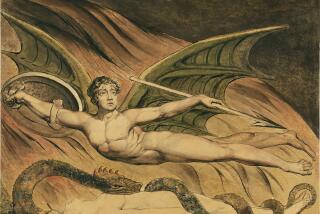Getty fattens its Rubens trove
- Share via
The J. Paul Getty Museum, aiming to deepen its collection of works by Peter Paul Rubens in his prime, has made its first major acquisition since the January arrival of Michael Brand as director.
The work, “The Calydonian Boar Hunt,” was painted on an oak panel, 23 1/4 by 35 5/8 inches, apparently in 1611 or 1612.
“It just shows to me a great master in his absolute peak form -- how magical painting can be, that deftness of touch,” Brand said.
Museum officials, who said they bought the work in late April from a London dealer, declined to disclose the price. But a smaller Rubens oil sketch of the same subject -- roughly 10-by-20 inches, again on a wood panel -- sold for $5.4 million at Christie’s London on Dec. 8.
Brand noted that Rubens repeatedly painted the boar-hunting scene, which is an episode drawn from the poetry of Ovid, but that the Getty’s version appears to be the artist’s first oil work on the subject.
He labeled the painting a rediscovery because until it resurfaced in London, it had previously been known only from the artist’s later versions of the scene. The Norton Simon Museum in Pasadena owns one of those later works, an oil painting thought to have been completed several years after the Getty’s.
Rubens is among the Old Master artists whose works have zoomed in value as art prices have inflated in recent years. In 2002, his work “The Massacre of the Innocents,” an oil painting on wood, roughly 56 inches square, fetched $76.7 million at Sotheby’s London, briefly making it the most expensive painting ever sold. That work too was a rediscovery after a long spell of obscurity and is thought to have been painted in about 1611.
Although the museum’s new acquisition has been out of public view for generations, Brand said, its attribution to Rubens is backed by leading specialists, and “we have no question about it.”
It was painted, Brand said, when the artist was in his mid-30s, having just returned to his native Antwerp, Belgium, after eight years in Italy. The Getty collection also includes two other Rubens works from the 1610-1612 period -- “The Return From War: Mars Disarmed by Venus” (a collaboration with Jan Brueghel the Elder) and “The Entombment” -- and about a dozen other Rubens paintings and drawings.
The Getty will hang the new work July 5 to coincide with the opening of its twin exhibitions “Rubens and Brueghel: A Working Friendship” and “Rubens and His Printmakers.”
While the museum has struggled to fend off allegations that it broke European laws in its zeal to buy Greek and Roman antiquities, some critics, including The Times’ art critic Christopher Knight, have faulted the Getty for failing to buy more work from other eras in recent years.
Through most of the 1980s and early 1990s, the Getty spent just shy of $100 million per year on acquisitions, but from 1998 to 2003 that figure dropped to about $65 million annually. Brand has vowed to make collecting a high priority but hasn’t committed to any particular spending targets.
The museum’s last major acquisitions were in 2005 -- “The Grand Canal, Venice, With Palazzo Bembo,” an 18th century work by Francesco Guardi (acquired in July) and the 19th century oil painting “The Milliners” by Edgar Degas (acquired in March).
Brand succeeded interim Director William Griswold, who succeeded Director Deborah Gribbon after her resignation in October 2004.
More to Read
The biggest entertainment stories
Get our big stories about Hollywood, film, television, music, arts, culture and more right in your inbox as soon as they publish.
You may occasionally receive promotional content from the Los Angeles Times.











